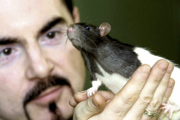 |
 |
|
|
 James Pfaus, who chairs the
Concordia Animal Care Committee, is pleased about the new facilities for
his rats.
Photo by Andrew Dobrowolskyj
James Pfaus, who chairs the
Concordia Animal Care Committee, is pleased about the new facilities for
his rats.
Photo by Andrew Dobrowolskyj
|
by Robert Scalia
James Pfaus enjoys interacting with his subjects, even if they trigger nasty
allergic reactions in himself.
“It doesn’t stop me from putting my face in their tummies and
blowing farts, tickling them and giving them little kisses. But I pay for
it afterwards.”
Like humans, rats need ample space, companionship and distraction. The associate
professor of psychology, who also chairs the Concordia Animal Care Committee,
wants to make sure they get a healthy dose of all three, “so that when
we use them in our studies we aren’t using rats that are impoverished,
emotionally or cognitively, but rats that are able to solve the difficult
little problems that we ask of them.”
Dr. Pfaus and nine other researchers from the Centre for Studies in Behavioural
Neurobiology (CSBN) are counting on state-of-the-art animal facilities in
the new Science Complex that will make both humans and rats happy.
The rats will get larger living quarters and researchers will be working
in a safer environment, where better air exchange in the animal colony rooms
will lessen the chance of allergic reactions.
Pfaus’s lab will be nearly twice the size of his present one in the
Hall Building. It will include a lab for examining brain tissue and another
suite of rooms to examine animal behaviour. The animal colonies will be
in a different area. This means that anyone who is allergic to rats but
is still interested in their brains’ biochemical processes can do research
but avoid contact with the animals.
Pfaus says the complex will be able to hold twice the number of rats as
the current animal care facilities. He has about 120 rats right now, a number
that can dip to 40 or soar to 200, depending on the number of students he
has at any one time doing research in his lab.
He’s interested in the rats’ sexual behaviour — what they
learn about sex and what in the brain causes this learning to occur —
and therefore relies on a large number of well-trained rats.
The same is true for Professor Jane Stewart, who is studying addiction.
Her animals are all trained to bar-press for intravenous drug rewards —
heroin in this case — and large numbers are needed for statistical
reliability.
Pfaus and Stewart collaborate, as do other members of the CSBN, on work
that ranges from the neurochemical regulation of drug addiction, reward,
sex, feeding and maternal behaviour, to electrophysiological studies of
neurons and physiological and molecular processes involved in learning and
memory.
Researchers at the CSBN have found, for example, that there are similarities
between the reward state induced by drugs like cocaine or heroin, and natural
rewards like sex. “It might explain why we sometimes play stupid human
tricks to get sex, just like addicts play to get their drugs.”
While no one at the CSBN is curing cancer, it doesn’t mean their research
is not important or justified, Pfaus said. “To the people who say that
animal research is immoral, I would say, that’s their opinion. It’s
not scientifically based. In fact, animal research actually saves lives
and improves the quality of life for us and for other animals.”
He points out that researchers must follow strict guidelines set by the
Canadian Council on Animal Care, a group composed of ethicists, researchers
and members of community-based animal rights groups, including the SPCA.
They visit labs regularly, reviewing lab protocols and offering recommendations.
The CSBN also runs a compulsory animal care seminar for its members several
times a year, Pfaus said. The course is listed on the CCAC Web site as a
national model for the rest of the country to follow.
Novice researchers are taught the proper way of handling animals. For example,
rats become stressed when you disrupt their balance, Pfaus explained, and
may become terrified if they are injected while they have no contact with
any kind of surface.
Learning to think like the animal is key. Pfaus remembers a time when researchers
kept rats in solitary confinement, separated in tiny cages with nothing
to do.
“I want my animals to be at their peak levels of performance, so I
give them a kind of complex ‘human’ environment in which they
can show what they are capable of.”
|
|
|



